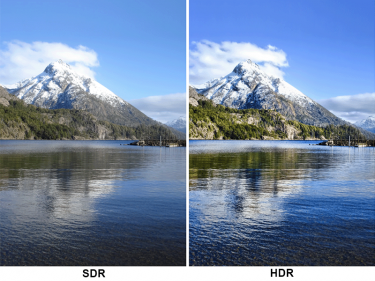| Українська | English | |||||||||||
|
|||||||||||
| News | About company | Service-centre | OB Van/SNG Rental | NextGen Energy Solutions | Contact us |
|
|
Engineering Service, Inc.
» News News For broadcasters, video content creators, and production companies alike, there's a big change coming. High Dynamic Range (HDR) and Wide Color Gamut (WCG) represent the next step of being “real” in the mind of the viewer with lighting that looks more natural, colors that are more saturated with vivid depth and realism.
When comparing a Standard Dynamic Range (SDR) image with HDR, the difference is staggering and you're left with a feeling that the SDR images you have been watching seem to be in a haze or fog, while HDR offers such a clear view, that it is almost a “window onto the world.” Images come to life with detail visible in the bright specular highlights that previously would have been clipped, and smooth detail in the shadows that would have once been solid black. With WCG, colors appear more saturated with vivid depth and realism. Overall the trifecta effect of high resolution, HDR and WGC produce a visually stunning image that the latest display technologies can now provide. With delivery to the home in this world of Netflix, Amazon Prime, YouTube and other popular video-on-demand type delivery systems, there has been a huge shift in how video content is monetized, delivered, and consumed. These over-the-top (OTT) distribution platforms have completely evolved customer expectations for content, driving greater demand for an ever-higher quality of experience. Additionally, these systems have broken an important content delivery barrier, making it possible to not only distribute a wide range of content for different devices, like SD and HD in various resolutions (360p, 480p, 720p, 1080p), but also set a path for 4K, HDR and even 8K video content. Production companies are now faced with the challenge of continuing to provide SDR, SDI, OTT, and HD formats, but also plan and provide for HDR and 4K productions—without breaking the bank. As broadcasters and program providers work to upgrade and improve their systems and networks, and as display manufacturers continue to push the technology envelope with larger, higher-resolution displays that deliver a stunning experience, it becomes obvious that the jump to HDR content is going to be huge. The good news is that most professional video cameras in use today have high dynamic range and that capability can be utilized with proper processing and monitoring. In fact, with the right tools in place, technology can enable broadcasters to optimize resources and prepare for HDR production now, while continuing to meet SDR and OTT requirements. For instance, sports and live event production are developing workflows that allow 4K and HD along with SDR and HDR production to take place within one truck or studio that provides multiple outputs for distribution. Facilities that can provide these kinds of services will likely see an increase in business. A TECH OPPORTUNITY To develop an HDR and WCG workflow, the key is to understand that we are using the same set of digital data to create the image. However we are using these bits more efficiently by developing different curves to optimize the conversion of light from the cameras through the signal path to the displays. This involves developing a set of “Look Up Tables” that describe the curves optimized for the various Camera Log formats that capture the image. Then the conversion to SDR, or HDR using Hybrid Log Gamma (HLG) or Perceptual Quantizer is possible. Each of these different conversions varies the white point and 18 percent gray of the signal. To manage this shift, manufacturers have integrated into waveform scopes something known as a “Stop Display,” a patented technology that provides a series of easy-to-use look-up tables that set curves where the camera video signal can be adjusted and properly converted. These adjusted stop points assure that the white point and gray point will always be at the same place, regardless of the format. By entering the appropriate configuration at the input stage, the conversion of the white and gray points for the SDR, HDR and Camera Log formats mean that the image being processed will always be at the same reference levels on the Stop Display, simplifying the operator’s task of monitoring the video levels. This type of log display allows operators to see the dynamic range of a camera by displaying the minimum and maximum of that range of the trace and then using parameters of the camera to adjust the levels to optimize performance for the shadows to the highlights. The operator is no longer required to remember the various white points and that 51 percent is for PQ ST2084 and 61 percent is for S Log 3—one simply selects the camera curve being used, and then aligns the trace to the 90 percent reflectance white point and 18 percent gray that correspond within the image. The development of the Stop Display continues innovation in the development of displays that simplify the tasks of camera operators and colorists such as Diamond, Spearhead and Lightning displays that are offered on the series of waveform monitors. FOLLOW THE MONEY As with many breakthrough media technologies, the drive toward HDR content will be fueled—and often paid for—by live events. As visually impactful as any HDR content may be, live sports and live events are what will start the evolution. Outdoor sporting events have the action, natural lighting, and color dynamics that HDR and WCG can bring to life and get the audience more involved, as if they really are at the game. Live events create shared experiences by bringing together exciting content to a sizable audience at a specific time. The live sporting event audience is not watching the big game on a smartphone. Early-adaptors and home theater owners want the larger-than-life experience by purchasing large, HDR displays and high-quality sound systems. These consumers invite their friends and family over on game day to share an experience. Many global and national broadcasters have been experimenting with live sports/HDR content for a few years now, and we may see some major announcements this year. They have been working to iron out the process and technology, and to establish a look for their brand to establish market leadership as pioneers in this new area. From live sports, to concerts, to other real-time events, there's no reason that regional and local production companies should not begin to leverage these new capabilities in their markets as well. The challenge ahead is found in that the step up to HDR video production requires a new set of tools. The workflows need to be adapted to provide multiple outputs for SDR and HDR. If we're going live in a 4K HDR world, we must prepare and get our production infrastructure ready. But for production trucks, OB vans and studios, there's still the obvious need to serve the SDR content business. After all, SDR is still paying the bills—for now. « To the list of news |
|
|||||||||||||||||
 |
+38 (044) 593-18-20 +38 (073) 593-18-20 +38 (096) 532-96-82 +38 (095) 532-96-82 Service center Telegram @Engineer_Service |

|
|
|||||
 |
e-mail: engineer-service.tv 15 Vavylovykh str., Kiev, 04060, Ukraine Authorized service centre of Panasonic, Sony, JVC, Fujinon, Canon |
|||||||







